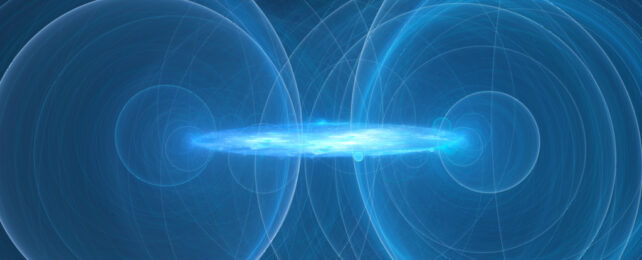Something is making the fabric of our Universe grow at an ever-accelerating rate, and scientists are truly stumped on what it could be.
Maybe gravity starts to misbehave over cosmic scales, or perhaps the roiling of pure emptiness creates some kind of negative pressure we're yet to explain.
For now, dark energy acts as a placeholder for descriptions of the mysterious tide of expansion, inviting all manner of speculation on what the poltergeist in the intergalactic shadows may actually look like.
Naman Kumar, a PhD student at the Indian Institute of Technology, has a few thoughts, which he outlined recently in a pair of published papers. One of his proposals arises from the assumption that our Universe isn't as lonely as it appears.
Rewind your watch far enough back through the ages, you'll eventually get to a point where all matter was confined in a hot, dense swarm of subatomic particles churning with possibility.
And before that? Something-something-something quantum physics. To fill in the missing details, we'd need a new theory that seamlessly melds general relativity's stretching fabric with the discrete threads of quantum mechanics, or replaces both with something radical and new.
Kumar's model starts with the quantum phenomenon of matter generation. Given the right conditions, virtual particles have an appreciable chance of popping into existence in an entangled partnership – one tiny piece of matter, and an antimatter twin.
This could be one positron and one electron, or one charm quark and one anti-charm quark.
Or, just perhaps, one Universe and one anti Universe, says Kumar.
The proposal isn't without precedent. Multiverses are a convenient way of filling in gaps that make our Universe look uncannily well suited for our very existence.
A similar suggestion was proposed several years ago by physicists Latham Boyle, Kieran Finn, and Neil Turok from the Perimeter Institute for Theoretical Physics in Canada.
Boyle, Finn, and Turok argue our Universe looks and behaves as smoothly as it does not thanks to a rapid period of early inflation, but because it was born with a twin that runs backward in time, identical apart from its mirror-image particles and flipped charges.
Kumar's version emerges as a consequence of a concept in quantum information theory called relative entropy. Putting it simply, this is a metric that puts a number to differences in distributions of probability across non-symmetrical systems, such as two Universes connected at a point in time.
Should our Universe have roared into existence with a backward-running, charge-flipped, mirror-image 'twin' constrained by the energy conditions of general relativity in the same way ours is, it would be entangled such that each system's energy naturally describes a rapidly expanding radius.
Problem solved, with no dark energy required.
Not satisfied with one bite of the theoretical cherry, Kumar has recently published a second proposal that emerges from hypothetical boundaries between dimensions called branes. By varying the tension in these borders of higher dimensional reality, Kumar shows how spacetime could expand at ever faster rates.
Evoking extra dimensions and mirror Universes to explain something as straightforward as the expansion of the Universe might seem like a stretch, but we may have come to a point in cosmology that we need to consider concepts that challenge our imagination a little.
Even the most outlandish proposals can hint at observations that confirm there really are particles and forces in the shadows where general relativity and quantum physics meet, or maybe reveal new layers of reality that have previously remained out of reach.
"After working on the problems of dark matter and dark energy, I can say that either we accept that general relativity is correct and we live in a dark universe with these elusive and peculiar dark matter particles and dark energy, or we accept that we live in a higher dimensional multiverse," Kumar explains in his ScienceX dialog.
This research was published in Gravitation and Cosmology and Europhysics Letters.
